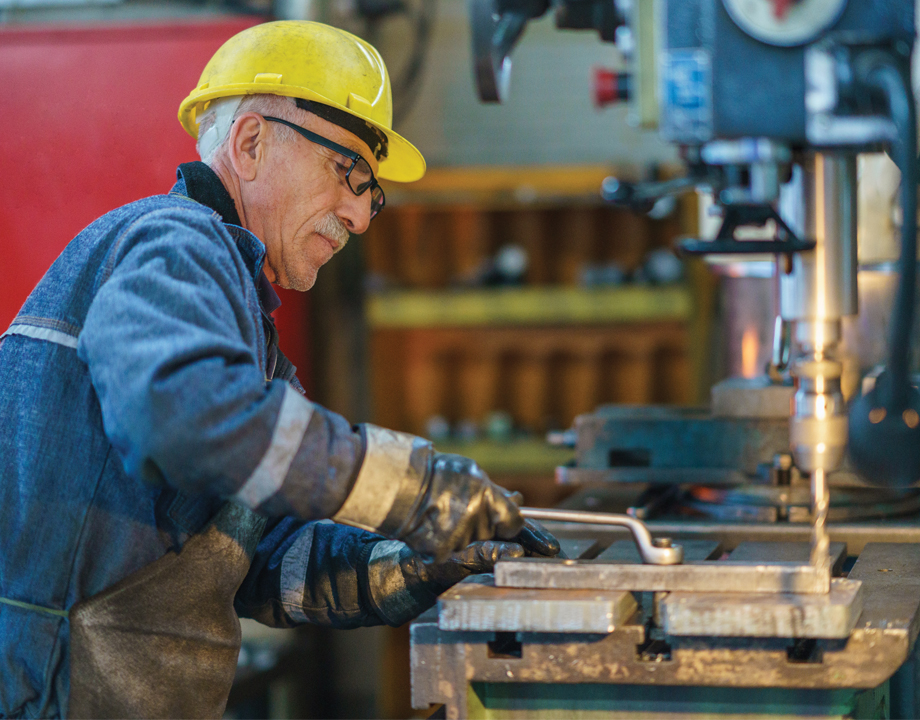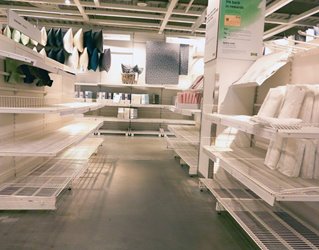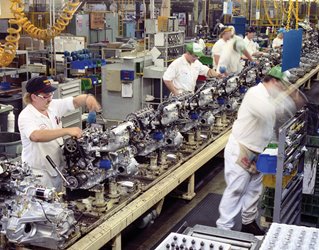Can Manufacturing Respond to the Great Resignation?
Can Manufacturing Respond to the Great Resignation?


Maintaining the nation’s manufacturing base means finding replacements for an aging cohort of technically skilled workers and engineers. Image: Getty
Affluent consumers in the industrialized world have spent the past few decades enjoying a historically unprecedented era of plenty. Browsing the aisles of an American big box store or a French hypermarché or scrolling through pages of results on Amazon.com would give the impression that the world’s materials needs had pretty much been met for those with the means to buy them. And products are often affordable by many. Nearly 1.4 billion smartphones—essentially portable supercomputers—were sold worldwide in 2020, and as of January 2022, a search on Amazon for “coffee” gives seven pages and more than 400 options.
The past two years have presented Western consumers with something different: bare shelves. The first weeks of the COVID-19 pandemic saw panic buying of everything from medical grade masks and hand sanitizer to pasta and toilet paper. As the pandemic went on, however, shortages persisted, cropping up in such seemingly random product lines as automobiles, furniture, and cream cheese. The culprit, consumers were told, were global supply chains.
Supply chains, the total system of companies, people, information, and resources needed to produce a product, aren’t new or even a function of globalization. Manufacturers have long relied upon suppliers for components or materials, which are then assembled or somehow transformed into a finished product. Outsourcing some activities or components allowed manufacturers to focus on their core competencies and for suppliers to focus on their own, leading to production efficiencies, and quality and cost improvements for products.
The establishment of a global trade system relatively free of tariffs encouraged expansion of supply chains to take advantage of regional strengths or economic advantage. In a world at peace with unhindered transport of goods and consistently followed laws of trade, global supply chains had little apparent risk. The benefits are often ubiquitous and unnoticed. Manufacturers in the United States could burn oil sourced from Canada and build with steel from Brazil or Germany; European consumers could buy phones manufactured in China using integrated circuits from Taiwan or Arizona.
The stress test of the COVID-19 pandemic uncovered vulnerabilities in the global supply chain, and subsequent shortages indicate they may not be displaying the robustness needed to cope with the increased level of economic activity. In the past six months, as the issue has become more acute, action has been taken in the United States at the federal level to improve ports and roads, increase the domestic manufacture of batteries and semiconductor chips, and even allow the continuous operation of the Port of Los Angeles.
Listen to the Authors: American Manufacturing and National Defense
While such measures can help move imported goods to consumers, there are other economic sectors that are also experiencing a labor shortage. One of them with great importance to the engineering profession is manufacturing, where there is an acute shortage of skilled labor, exacerbated by pandemic effects. In fact, the labor shortage currently faced by manufacturers is part of a long-term trend that the pandemic merely accelerated. One solution to supply difficulties is to simplify supply chains, likely by manufacturing goods close to the customer. Restocking the nation’s shelves for the decades to come will require more than reestablishing logistics—it needs people. It demands renewed investment in the manufacturing and technical workforce and the training of millions of skilled workers required for high-tech manufacturing.
By some measures, manufacturing has rebounded from the COVID-19 pandemic. According to data from the U.S. Federal Reserve, manufacturing output is 2 percent higher in December 2021 than it was in January 2020, on the eve of the pandemic. But the same data set shows that manufacturing employment dove from 12.8 million in January 2020 to 11.4 million in April 2020 and was still well below the pre-pandemic level at the start of 2022.
The shortfall in employment isn’t due to lack of job openings but rather the lack of skilled workers willing to take the open jobs at factories. What changed during the pandemic to bring the skilled labor shortages to the crisis point? To be sure, some of this is due to the coronavirus itself and the sick days and forced workplace closures the pandemic has produced directly. But the pandemic has exposed other fault lines in the workforce.
For instance, many people who were displaced due to the pandemic-related closure of their workplace changed jobs or even their careers. Some workers have found better paying jobs or have left companies with ineffective or difficult management or demanding work schedules for ones with more positive environments. Companies that have relied on low-wage, part-time workers now find that they either have to offer competitive wages, adjust work hours, and become better places to work—or face labor shortages.
In other instances, the displacement from office work has spurred professionals to become more entrepreneurial. Many professionals and their employers have benefitted from telework or work-from-home arrangements and this trend is certain to continue. But the time at home (and time saved due to reduced commuting) has enabled some highly skilled professionals to explore alternatives and create their own companies.
Another, counterintuitive factor contributing to the recent labor shortage is automation. Manufacturers in high-wage countries have pursued automation to help stay competitive when faced with imports from low-wage nations. But automated factories need workers with a different set of skills than traditional factories. For example, instead of assembly workers, robot setup and programming technicians are needed. But the skills required for this, and other technical careers are not obtained quickly.
These factors have contributed to a labor shortage that has exacerbated the supply-chain challenges. In normal circumstances, these would have a relatively short-term impact. For example, companies cannot last years without sufficient labor, so they will adjust their wages, redouble their recruiting, or train more technicians to bring their workforce in line with their needs.
Unfortunately, much the way a storm surge can be amplified by a high tide and sea-level rise, the short-term labor disruption brought about by the pandemic is building on a larger demographic trend.
More about Manufacturing: 5G Pilot to Test Factory of the Future Concept
For a generation, the number of workers in the U.S. manufacturing sector remained constant. According to the Bureau of Labor Statistics, the seasonally adjusted manufacturing workforce in January 1966 was 17.1 million; by January 2001, after 35 years of boomtime hiring and recession-forced layoffs, it was 17.1 million. At the same time, the U.S. population had increased from 202 million to 284 million, meaning that the share of the population working in manufacturing had decreased during that period. Noting that trend, economists in the 1980s and 1990s claimed that the United States was in a post-manufacturing economy. Supporting that view was the offshoring of manufacturing activity to low-wage countries starting around 2000, which had a dramatic impact on the number of manufacturing workers. By January 2010, only 11.5 million were employed in manufacturing.
The demise of American manufacturing was overblown. Even as manufacturing employment stagnated and then declined, manufacturing output increased because of dramatic increases in productivity over this timeframe. The country is still the second-largest manufacturer, producing more than $2.5 trillion in goods. But the reduced share of workers in manufacturing and the popular conception of a post-industrial, service-based economy became a drag on workforce recruitment. Some quipped that 21st century manufacturing in the U.S. could be summed up with five Ds: dumb, dark, dirty, dangerous, and disappearing.
The worldview that marginalizes manufacturing is a dangerous delusion because it leads to policy and personal decisions that are harmful. For example, a misinformed high school guidance counsellor may advise students to avoid the dangerous manufacturing profession, and instead study a different discipline in a community college or university. This advice would be counter to all career earning statistics and economic impact data and harmful to the long-term economic competitiveness of the nation.
For many years, the number of young adults pursuing manufacturing employment declined. Community colleges found that the technical arts programs were expensive and required instructors with knowledge and skills that were difficult to replace; they were eliminated when instructors retired. Universities pursued research funds, which were heavily skewed toward medicine, biomaterials, and nanotechnology. This also was poorly aligned to industry needs: Manufacturing engineers and metallurgists became increasingly rare but urgently needed.
Those familiar with modern manufacturing recognize that none of the five Ds are generally applicable. Manufacturing is essential for modern economies. Manufacturing companies are leaders in the application of computer technologies, automation, creative design, and teamwork. These are characteristics of employment that workers find challenging, fulfilling, and enjoyable. But individuals who could thrive in such an environment were advised to consider alternative specializations. This problem has cast a long shadow.
For some time, the relative lack of new workers in manufacturing has been offset by the long tenure of existing workers in that industry. These experienced workers could be more productive than new hires, so manufacturers were happy to retain them. According to a 2019 report by the National Association of Manufacturers, the manufacturing workforce is older than the national median age and 25 percent is over 55 years old. The large cohort of workers that came to adulthood during the golden age of modern manufacturing associated with the Space Race and global business expansion began disappearing before the pandemic, as the Baby Boomer generation started to retire from the workforce. Manufacturers referred to a “silver tsunami” of retirements, and the difficulty in finding replacement workers.
While the impact of population trends on economic welfare are not the daily concern of most citizens, those that pay attention to their effect can predict impact long in advance. For instance, Manufacturing USA is a network of innovation institutes to promote the jobs and industries of the future in advanced technologies. Even though the oldest Baby Boomers were only beginning to retire then and unemployment was relatively low, the demographic trends were quite apparent and frightening. That’s why, in addition to large-scale public-private collaboration on technology and manufacturing demonstration activities, Manufacturing USA incorporated a strong focus on workforce development—providing necessary knowledge and skills to the unemployed or underemployed in emerging technologies and expanding the manufacturing workforce.
The workforce development efforts were successful, but as can be seen from the current labor shortage, they were not sized appropriately and were inadequately funded to have the desired impact. Compounding the demographic projections was the unforeseeable impact of the COVID-19 pandemic. Workers near retirement who were left with fewer hours or in work-from-home situations starting in 2020 decided their personal finances could support part-time employment elsewhere or even full retirement.
Manufacturing Blog: Software Can Help Identify Additive Manufacturing Prospects
This phenomenon has been called the “Great Resignation” in the media, although the transition was often not complete retirement. These accelerated resignations and retirements by Baby Boomers, who make up a larger than typical share of manufacturing workers, have led to accentuated labor shortages for manufacturers and a compromise in a mentoring program to train replacements.
The focus on manufacturing workers may give the impression of workers in a factory that are directly tied to production. This definition is limited and inaccurate; the same trends and shortages apply to engineers and scientists as well. The magnitude of the problem is enormous. It has been estimated that, even after increased recruitment of new employees, a shortfall in excess of 2 million skilled workers will exist in the American manufacturing sector, and over 300,000 too few engineers.
The Great Resignation will have a larger, longer-term impact on the American economy than the shortage of toys at Christmas or slow delivery of automobiles associated with supply chains of integrated circuits. The shortage of labor also influences placement of manufacturing facilities. If a workforce cannot be recruited in one location, then a corporation has no alternative but to locate its facilities elsewhere, even if that’s in another country.
While offshoring production solves the workforce issue, it increases the likelihood of supply-chain disruption associated with pandemic, armed conflict, or natural or man-made disaster. This problem can be partially addressed through technology, namely the use of information technology, or automation to ease the personnel shortage. However, this can only ameliorate the problem, not eliminate it.
The combination of the long-term labor shortage and offshored production has serious implications for economic welfare and national defense. Reversing the trends should be a national priority but requires a consistency of purpose and dedication to solutions.
What would it take? At a minimum, programs with workforce development components, especially Manufacturing USA, should be fully funded and expanded to match investment by foreign competitors.
For example, the German Fraunhofer program has an annual budget in excess of $2 billion. The Manufacturing USA program is analogous to the Fraunhofer program, but has received less than this amount over the past 10 years. This failure to invest in the high-tech workforce is now a national emergency.
While workforce development programs have generally focused on factory workers, the individuals who design the products or factories are also incredibly important and they, too, have been leaving the workforce during the Great Resignation. By some estimates, to stay competitive in manufacturing the United States needs to double the number of engineering graduates within ten years.
To get younger scientists and engineers interested in the manufacturing sector, a concerted effort could be made to expand research experiences for undergraduate programs in fields related to manufacturing. Companies could provide more internship opportunities for engineering students, and the federal government could fund more national graduate research fellowships for manufacturing scientists and engineers.
Listen to the Podcast: Investing in Industry 4.0 Solutions
With any luck, the nation’s shelves will be fully stocked again by summer. But ensuring that the U.S. can sustain the current era of material plenty means more than unclogging ports and reestablishing logistics. It demands making manufacturing a desired field of work for the most capable people of the next generation. And that requires investing in the technical workforce and the training of millions of skilled workers, starting today.
Steven R. Schmid is the Belk-Woodward Distinguished Professor of Engineering at the University of North Carolina at Charlotte and an ASME Fellow. Schmid also is an associate editor of the Journal of Manufacturing Science and Engineering. Shreyes N. Melkote is also an ASME Fellow and holds the Morris M. Bryan Jr. Professorship in Mechanical Engineering at the Georgia Institute of Technology in Atlanta as well as executive director of the institute’s Novelis Innovation Hub.
The past two years have presented Western consumers with something different: bare shelves. The first weeks of the COVID-19 pandemic saw panic buying of everything from medical grade masks and hand sanitizer to pasta and toilet paper. As the pandemic went on, however, shortages persisted, cropping up in such seemingly random product lines as automobiles, furniture, and cream cheese. The culprit, consumers were told, were global supply chains.
Supply chains, the total system of companies, people, information, and resources needed to produce a product, aren’t new or even a function of globalization. Manufacturers have long relied upon suppliers for components or materials, which are then assembled or somehow transformed into a finished product. Outsourcing some activities or components allowed manufacturers to focus on their core competencies and for suppliers to focus on their own, leading to production efficiencies, and quality and cost improvements for products.
The establishment of a global trade system relatively free of tariffs encouraged expansion of supply chains to take advantage of regional strengths or economic advantage. In a world at peace with unhindered transport of goods and consistently followed laws of trade, global supply chains had little apparent risk. The benefits are often ubiquitous and unnoticed. Manufacturers in the United States could burn oil sourced from Canada and build with steel from Brazil or Germany; European consumers could buy phones manufactured in China using integrated circuits from Taiwan or Arizona.
The stress test of the COVID-19 pandemic uncovered vulnerabilities in the global supply chain, and subsequent shortages indicate they may not be displaying the robustness needed to cope with the increased level of economic activity. In the past six months, as the issue has become more acute, action has been taken in the United States at the federal level to improve ports and roads, increase the domestic manufacture of batteries and semiconductor chips, and even allow the continuous operation of the Port of Los Angeles.
Listen to the Authors: American Manufacturing and National Defense
While such measures can help move imported goods to consumers, there are other economic sectors that are also experiencing a labor shortage. One of them with great importance to the engineering profession is manufacturing, where there is an acute shortage of skilled labor, exacerbated by pandemic effects. In fact, the labor shortage currently faced by manufacturers is part of a long-term trend that the pandemic merely accelerated. One solution to supply difficulties is to simplify supply chains, likely by manufacturing goods close to the customer. Restocking the nation’s shelves for the decades to come will require more than reestablishing logistics—it needs people. It demands renewed investment in the manufacturing and technical workforce and the training of millions of skilled workers required for high-tech manufacturing.
Crisis Point
By some measures, manufacturing has rebounded from the COVID-19 pandemic. According to data from the U.S. Federal Reserve, manufacturing output is 2 percent higher in December 2021 than it was in January 2020, on the eve of the pandemic. But the same data set shows that manufacturing employment dove from 12.8 million in January 2020 to 11.4 million in April 2020 and was still well below the pre-pandemic level at the start of 2022.
The shortfall in employment isn’t due to lack of job openings but rather the lack of skilled workers willing to take the open jobs at factories. What changed during the pandemic to bring the skilled labor shortages to the crisis point? To be sure, some of this is due to the coronavirus itself and the sick days and forced workplace closures the pandemic has produced directly. But the pandemic has exposed other fault lines in the workforce.
For instance, many people who were displaced due to the pandemic-related closure of their workplace changed jobs or even their careers. Some workers have found better paying jobs or have left companies with ineffective or difficult management or demanding work schedules for ones with more positive environments. Companies that have relied on low-wage, part-time workers now find that they either have to offer competitive wages, adjust work hours, and become better places to work—or face labor shortages.
In other instances, the displacement from office work has spurred professionals to become more entrepreneurial. Many professionals and their employers have benefitted from telework or work-from-home arrangements and this trend is certain to continue. But the time at home (and time saved due to reduced commuting) has enabled some highly skilled professionals to explore alternatives and create their own companies.
Another, counterintuitive factor contributing to the recent labor shortage is automation. Manufacturers in high-wage countries have pursued automation to help stay competitive when faced with imports from low-wage nations. But automated factories need workers with a different set of skills than traditional factories. For example, instead of assembly workers, robot setup and programming technicians are needed. But the skills required for this, and other technical careers are not obtained quickly.
These factors have contributed to a labor shortage that has exacerbated the supply-chain challenges. In normal circumstances, these would have a relatively short-term impact. For example, companies cannot last years without sufficient labor, so they will adjust their wages, redouble their recruiting, or train more technicians to bring their workforce in line with their needs.
Unfortunately, much the way a storm surge can be amplified by a high tide and sea-level rise, the short-term labor disruption brought about by the pandemic is building on a larger demographic trend.
More about Manufacturing: 5G Pilot to Test Factory of the Future Concept
For a generation, the number of workers in the U.S. manufacturing sector remained constant. According to the Bureau of Labor Statistics, the seasonally adjusted manufacturing workforce in January 1966 was 17.1 million; by January 2001, after 35 years of boomtime hiring and recession-forced layoffs, it was 17.1 million. At the same time, the U.S. population had increased from 202 million to 284 million, meaning that the share of the population working in manufacturing had decreased during that period. Noting that trend, economists in the 1980s and 1990s claimed that the United States was in a post-manufacturing economy. Supporting that view was the offshoring of manufacturing activity to low-wage countries starting around 2000, which had a dramatic impact on the number of manufacturing workers. By January 2010, only 11.5 million were employed in manufacturing.
The demise of American manufacturing was overblown. Even as manufacturing employment stagnated and then declined, manufacturing output increased because of dramatic increases in productivity over this timeframe. The country is still the second-largest manufacturer, producing more than $2.5 trillion in goods. But the reduced share of workers in manufacturing and the popular conception of a post-industrial, service-based economy became a drag on workforce recruitment. Some quipped that 21st century manufacturing in the U.S. could be summed up with five Ds: dumb, dark, dirty, dangerous, and disappearing.
The worldview that marginalizes manufacturing is a dangerous delusion because it leads to policy and personal decisions that are harmful. For example, a misinformed high school guidance counsellor may advise students to avoid the dangerous manufacturing profession, and instead study a different discipline in a community college or university. This advice would be counter to all career earning statistics and economic impact data and harmful to the long-term economic competitiveness of the nation.
For many years, the number of young adults pursuing manufacturing employment declined. Community colleges found that the technical arts programs were expensive and required instructors with knowledge and skills that were difficult to replace; they were eliminated when instructors retired. Universities pursued research funds, which were heavily skewed toward medicine, biomaterials, and nanotechnology. This also was poorly aligned to industry needs: Manufacturing engineers and metallurgists became increasingly rare but urgently needed.
Those familiar with modern manufacturing recognize that none of the five Ds are generally applicable. Manufacturing is essential for modern economies. Manufacturing companies are leaders in the application of computer technologies, automation, creative design, and teamwork. These are characteristics of employment that workers find challenging, fulfilling, and enjoyable. But individuals who could thrive in such an environment were advised to consider alternative specializations. This problem has cast a long shadow.
Resignation Nation
For some time, the relative lack of new workers in manufacturing has been offset by the long tenure of existing workers in that industry. These experienced workers could be more productive than new hires, so manufacturers were happy to retain them. According to a 2019 report by the National Association of Manufacturers, the manufacturing workforce is older than the national median age and 25 percent is over 55 years old. The large cohort of workers that came to adulthood during the golden age of modern manufacturing associated with the Space Race and global business expansion began disappearing before the pandemic, as the Baby Boomer generation started to retire from the workforce. Manufacturers referred to a “silver tsunami” of retirements, and the difficulty in finding replacement workers.
While the impact of population trends on economic welfare are not the daily concern of most citizens, those that pay attention to their effect can predict impact long in advance. For instance, Manufacturing USA is a network of innovation institutes to promote the jobs and industries of the future in advanced technologies. Even though the oldest Baby Boomers were only beginning to retire then and unemployment was relatively low, the demographic trends were quite apparent and frightening. That’s why, in addition to large-scale public-private collaboration on technology and manufacturing demonstration activities, Manufacturing USA incorporated a strong focus on workforce development—providing necessary knowledge and skills to the unemployed or underemployed in emerging technologies and expanding the manufacturing workforce.
The workforce development efforts were successful, but as can be seen from the current labor shortage, they were not sized appropriately and were inadequately funded to have the desired impact. Compounding the demographic projections was the unforeseeable impact of the COVID-19 pandemic. Workers near retirement who were left with fewer hours or in work-from-home situations starting in 2020 decided their personal finances could support part-time employment elsewhere or even full retirement.
Manufacturing Blog: Software Can Help Identify Additive Manufacturing Prospects
This phenomenon has been called the “Great Resignation” in the media, although the transition was often not complete retirement. These accelerated resignations and retirements by Baby Boomers, who make up a larger than typical share of manufacturing workers, have led to accentuated labor shortages for manufacturers and a compromise in a mentoring program to train replacements.
The focus on manufacturing workers may give the impression of workers in a factory that are directly tied to production. This definition is limited and inaccurate; the same trends and shortages apply to engineers and scientists as well. The magnitude of the problem is enormous. It has been estimated that, even after increased recruitment of new employees, a shortfall in excess of 2 million skilled workers will exist in the American manufacturing sector, and over 300,000 too few engineers.
Youth Movement
The Great Resignation will have a larger, longer-term impact on the American economy than the shortage of toys at Christmas or slow delivery of automobiles associated with supply chains of integrated circuits. The shortage of labor also influences placement of manufacturing facilities. If a workforce cannot be recruited in one location, then a corporation has no alternative but to locate its facilities elsewhere, even if that’s in another country.
While offshoring production solves the workforce issue, it increases the likelihood of supply-chain disruption associated with pandemic, armed conflict, or natural or man-made disaster. This problem can be partially addressed through technology, namely the use of information technology, or automation to ease the personnel shortage. However, this can only ameliorate the problem, not eliminate it.
The combination of the long-term labor shortage and offshored production has serious implications for economic welfare and national defense. Reversing the trends should be a national priority but requires a consistency of purpose and dedication to solutions.
What would it take? At a minimum, programs with workforce development components, especially Manufacturing USA, should be fully funded and expanded to match investment by foreign competitors.
For example, the German Fraunhofer program has an annual budget in excess of $2 billion. The Manufacturing USA program is analogous to the Fraunhofer program, but has received less than this amount over the past 10 years. This failure to invest in the high-tech workforce is now a national emergency.
While workforce development programs have generally focused on factory workers, the individuals who design the products or factories are also incredibly important and they, too, have been leaving the workforce during the Great Resignation. By some estimates, to stay competitive in manufacturing the United States needs to double the number of engineering graduates within ten years.
To get younger scientists and engineers interested in the manufacturing sector, a concerted effort could be made to expand research experiences for undergraduate programs in fields related to manufacturing. Companies could provide more internship opportunities for engineering students, and the federal government could fund more national graduate research fellowships for manufacturing scientists and engineers.
Listen to the Podcast: Investing in Industry 4.0 Solutions
With any luck, the nation’s shelves will be fully stocked again by summer. But ensuring that the U.S. can sustain the current era of material plenty means more than unclogging ports and reestablishing logistics. It demands making manufacturing a desired field of work for the most capable people of the next generation. And that requires investing in the technical workforce and the training of millions of skilled workers, starting today.
Steven R. Schmid is the Belk-Woodward Distinguished Professor of Engineering at the University of North Carolina at Charlotte and an ASME Fellow. Schmid also is an associate editor of the Journal of Manufacturing Science and Engineering. Shreyes N. Melkote is also an ASME Fellow and holds the Morris M. Bryan Jr. Professorship in Mechanical Engineering at the Georgia Institute of Technology in Atlanta as well as executive director of the institute’s Novelis Innovation Hub.










